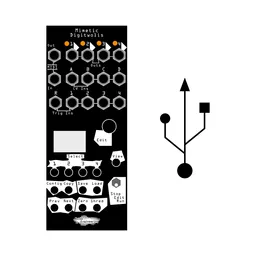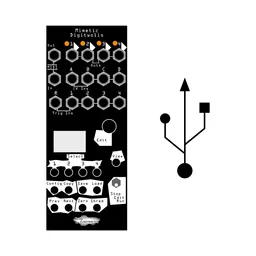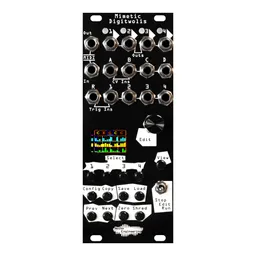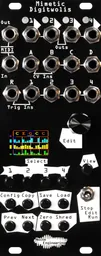An all-new firmware update is now available for Mimetic Digitwolis. This update brings about some highly requested features, including a few flavors of microtonal scales and improved scale editing, CV over sequence length and clock division, new randomization options, MIDI improvements, and more!
The user manual has been updated to reflect all changes, so you can reference all the new features with ease. The full changelog can be found at the end of this post, too.
Menu updates
To accommodate all of the new features we’ve added, the lane submenus have been slightly rearranged. The Record submenu has been renamed to Modify, and now contains the Shred and Zero input mappings, as well as Nudge and Dist – more on those two in a bit.
There’s also a new way to navigate the menu: Prev and Next can be used in place of turning the encoder, and Zero can be used to select, if you prefer buttons to knobs.
Easier editing mid-performance
We’ve always touted MD2 as a performance sequencer, and we’re always looking for ways to improve its performance workflow. Now, when the transport switch is set to Edit, the sequence will keep playing as usual, but steps can be navigated and edited separately for unobtrusive editing during playback.
New scales: modes and microtones
You asked, and we’ve answered. MD2 now features new ways to quickly create scales, as well as a set of microtonal options, for Note and Quantizer lanes.
The keyboard-based editing you know is still available, but now, pressing Shred while over the keyboard will generate a random scale.
The new Type parameter in the Scale submenu allows you to select four other scale-creating modes, too. Diaton works similarly to Keys mode, but allows you to select a root note and mode for quick note selection. Symmet enables algorithmic note selection with three simple parameters, inspired by The Thesaurus of Scales and Melodic Patterns by Nicolas Slonimsky.
Finally, two microtonal modes have been added. Equal allows you to evenly divide an octave into an arbitrary number of steps, from 1 to 24 divisions. Ratio enables Partch Limit scales based on tone diamonds, inspired by Harry Partch’s writings (and probably inspired by Max Friedrich Meyer’s work). Up to four limits can be enabled, and notes are mapped to a single value using a simple algorithm.
Nudge
While Shred has been a favorite way to randomize since the inception of the original MD, Nudge adds a whole new way to modify sequences on the fly by slightly randomizing the current step value.
Nudge has two parameters. Dist, short for Distribute, sets the direction of randomization, from 0 to 16. When set to 8, nudging a step will keep its value near the current setting. Above 8, and it will tend to go higher, and below 8 it will tend to go lower. Dist can be CV controlled, too.
Nudge itself has a trigger mapping for external activation, as well as two new shortcuts. Save+Shred will nudge the current step, and Save+Load+Shred will nudge all steps.
New CV destinations
If you take a look at the Sequence submenu, you’ll notice some new CV destinations. Quite a few users requested CV control over the length of the sequence and clock division, so now you can adjust the timing and step count of your sequences with external modulators!
More MIDI
Some small updates have been made for MIDI output, too. Note and Trig lanes now have a Time parameter in their MIDI submenu that will adjust the length of the output MIDI note, from instantaneous to just over a second. This improves compatibility with some polyphonic MIDI-controlled modules, and makes it easier to dial in notes that sound good, too.
And if you want to do some CV to MIDI patches, the quantizer can now be offset in octaves in the MIDI submenu.
When Transport is set to the internal Clock setting, MIDI clock can also be output, too!
Miscellaneous updates and bug fixes
It wouldn’t be a firmware update without some bug fixes, so you can look forward to improved usability and an even smoother experience when patching with your MD2.
How to update your firmware
As usual, the update process is straightforward, and only takes about five minutes. All you’ll need is a computer with an internet connection and Chromium-based browser, your module, and a data-capable micro USB cable like this one.
First, power off your case, and uninstall the module from your system. Then, navigate to the firmware page on our website, and click the Open Wizard button. This will give you step-by-step instructions to install the firmware update on your Mimetic Digitwolis.
With all of these new features, there’s a lot to take in – if you have any questions or comments, drop us a line!
Changelog
-
Edit mode's behavior has been changed: lane outputs will follow the playhead, but steps can separately be selected for editing.
-
Some menus have been slightly reorganized to accomadate new features.
-
"Record" menu has been renamed to "Modify"
-
Modify menu now contains the Zero and Shrd mappings (previously in the Sequence menu)
-
New function: Nudge
-
Nudge slightly randomizes a current value
-
Save+Shred nudges the current step
-
Save+Load+Shred nudges all steps
-
Modify: Nudg has been added as a trigger mapping
-
New parameter and CV mapping: Dist
-
Available as an editable value and CV mapping in Modify menu
-
Changes the distribution curve of Nudge
-
Dist values above 8 will bias towards raising values
-
Dist values below 8 will bias towards lowering values
-
Added a new way to navigate the menu
-
Prev/Next buttons move to previous/next line
-
Zero selects a menu item
-
Scale menu: keyboard revamp
-
New menu navigation options can be used here, too
-
Shred button will now generate a random scale when cursor is over the keyboard
-
Load+Zero will turn all notes off
-
Copy+Lane select will copy the current lane's scale to the pressed lane
-
New Scale: Type parameter
-
Type: Diaton enables Root and Mode parameters for easy scale presets
-
Type: Symmet enables algorithmic 12-tet scale selection, inspired by The Thesaurus of Scales and Melodic Patterns by Nicolas Slonimsky
-
Type: Equal enables Tet parameter, allowing arbitrary note count per octave for simple microtonal scales
-
Type: Ratio enables Partch Limit scales
-
New CV destinations
-
Seq: Len CV changes the length of the sequence
-
Seq: Div CV changes the clock division of the lane
-
Transport: Clock can now output MIDI clock.
-
Added MIDI: Time parameter for Trig and Note lanes, which sets the length of the output MIDI note in ms for improved compatibility
-
Added MIDI: Octv parameter for Qtiz lanes, which sets the starting octave for output MIDI notes
-
Removed a few unintended button behaviors from Qtiz lanes
-
Fixed a bug related to Transport: Trig
-
Unified ramp shortcut behavior
-
Other minor bug fixes







